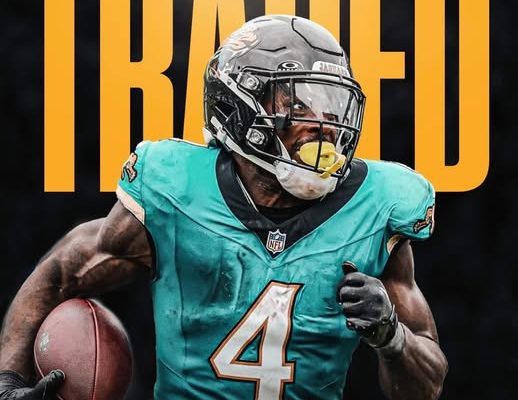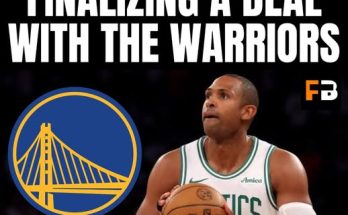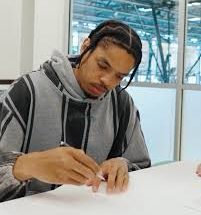The NFL never fails to deliver drama, even outside the prime months of the season, and today’s breaking news about the Jacksonville Jaguars trading running back Tank Bigsby to the Philadelphia Eagles in exchange for a pair of 2026 draft picks—a fifth and a sixth rounder—will certainly spark conversation across the football community. When moves like this happen, it is never just about the exchange of names or numbers on paper. It is about strategy, team-building philosophies, depth chart adjustments, and even the long-term outlook of both franchises. Fans of both the Jaguars and the Eagles, as well as football lovers in general, will find a lot to unpack from this trade, and it is the kind of move that may not dominate the headlines like a blockbuster quarterback deal but can still carry significant weight as the season and years progress.
For the Jaguars, the decision to part ways with Tank Bigsby after investing in him as a draft pick not too long ago is intriguing. Bigsby was seen as a complementary back to Travis Etienne, someone who could shoulder short-yardage duties, spell Etienne when needed, and provide toughness in the ground game. But as often happens in the NFL, opportunity and performance must align perfectly for a young player to cement their role. The Jaguars clearly decided that their roster and offensive scheme did not necessitate keeping Bigsby long-term. By flipping him for future draft assets, Jacksonville is signaling that they value the flexibility of those mid-round picks in 2026 over keeping Bigsby on the roster, especially if he was unlikely to become a central piece of their offense. Some fans may question if this was giving up too soon, while others will point to the importance of maximizing value when a player is not a perfect fit.
From Philadelphia’s perspective, this move makes perfect sense. The Eagles have been known to stockpile running backs and rotate them heavily, playing to their offensive strengths. Tank Bigsby is not arriving in Philadelphia to be a franchise back or a guaranteed starter, but rather to add depth, toughness, and competition to a backfield that thrives on versatility. With the Eagles’ offensive line among the best in the league, Bigsby could find himself rejuvenated in a system that creates rushing lanes and leverages committee approaches. It is a situation where he does not have to be “the guy,” but he can carve out a role that plays to his skill set. That is often when running backs flourish—when they are not asked to carry the entire load but can specialize in certain packages and situations.
The draft pick compensation is another interesting angle here. A fifth and a sixth rounder in 2026 may not sound like much, but in the modern NFL, teams are constantly looking for additional draft capital. Those mid- to late-round picks can be bundled in trades, used to take chances on developmental players, or even flipped again in future deals. For Jacksonville, this is about keeping flexibility for the future while continuing to mold the roster under Doug Pederson’s vision. For Philadelphia, giving up those picks is a low-risk gamble. The Eagles believe they are in win-now mode, and adding an extra running back who may help keep their offense fresh during a playoff push is worth much more than holding onto distant picks that may or may not pan out.
This trade also reflects how the running back position continues to be viewed in the league. We have seen it time and time again: franchises are hesitant to invest heavily in running backs, opting instead to rotate fresh legs, draft new talent, and trade for low-cost additions. Bigsby’s move to Philadelphia is another reminder that unless you are one of the truly elite running backs, the NFL sees the position as interchangeable to some degree. Still, for the individual players, every opportunity is a chance to prove themselves, and Bigsby now has a platform to show he belongs in a competitive, playoff-caliber environment.
Fans in Jacksonville will no doubt have mixed feelings. On one hand, there is disappointment when a recent draft pick is shipped out before his full potential is realized. It feels like a wasted opportunity, especially when so much scouting and development go into drafting players. On the other hand, the Jaguars are in a position where they need to continue building around Trevor Lawrence, reinforcing both sides of the ball, and ensuring that they have the draft capital to keep their window open in the AFC South. If Bigsby was not going to break through as a consistent contributor, then turning him into future assets may have been the most logical step, even if it stings in the short term.
In Philadelphia, the excitement will be more immediate. Eagles fans know how much this team values depth and rotation, and Bigsby will be welcomed as another weapon in an already dynamic offense. His downhill style can mesh well with their system, and the chance to reset his career in a new environment could prove valuable. Fans will speculate about how he might be used alongside the likes of other backs, and whether he can thrive in red-zone and short-yardage situations. There is always a certain buzz when a new player arrives, especially when that player was recently considered to have untapped potential.
One of the more fascinating elements of this move is how it could play out in the narrative of both franchises moving forward. If Bigsby finds success in Philadelphia, it may lead to criticism of the Jaguars for giving up too early. Conversely, if he struggles or fails to find a consistent role, Jacksonville will be seen as having made a savvy decision to move on before his value diminished further. That is the nature of trades in the NFL—judgments are made not just at the moment, but years down the line, once the outcomes are clearer.
This trade also invites larger questions about roster construction in the NFL. Should teams invest more in developing running backs, or is it wiser to keep churning through affordable, short-term contributors? Is the committee approach truly the future of the position, or will there always be value in trying to find a workhorse who can shoulder a heavy load? Fans will debate these questions endlessly, and trades like this provide fresh examples to point to on either side of the argument.
As for Bigsby himself, this is a pivotal moment in his career. Young players who get traded often have two choices: view the move as a setback or see it as a fresh start. If he embraces the opportunity in Philadelphia, commits to his role, and maximizes his chances in a talented offense, this could be the launch point of a successful second act. If not, he risks being remembered as a player who never lived up to expectations. In the NFL, opportunities can be fleeting, and this is one he must seize.
For fans reading this, the conversation is just as important as the trade itself. How do you feel about Jacksonville’s decision to move on from Bigsby so quickly? Do you think the Eagles are making a smart move by adding him to their running back room, or is this simply a minor depth move that will not change much? And perhaps most importantly, what does this trade say about the modern value of running backs in the NFL? These are the kinds of discussions that bring the sport to life beyond the X’s and O’s, and they are worth diving into.
So let’s hear your thoughts. Was this a win-win deal, or did one team clearly come out ahead? Do you believe Bigsby will thrive in Philadelphia, or do you think Jacksonville will benefit more from the draft picks down the road? The floor is open—drop your comments, share your predictions, and let’s discuss what this trade really means for both teams and for the league as a whole.



